
My Voice Email for Outlook 2.0 serial key or number
My Voice Email for Outlook 2.0 serial key or number
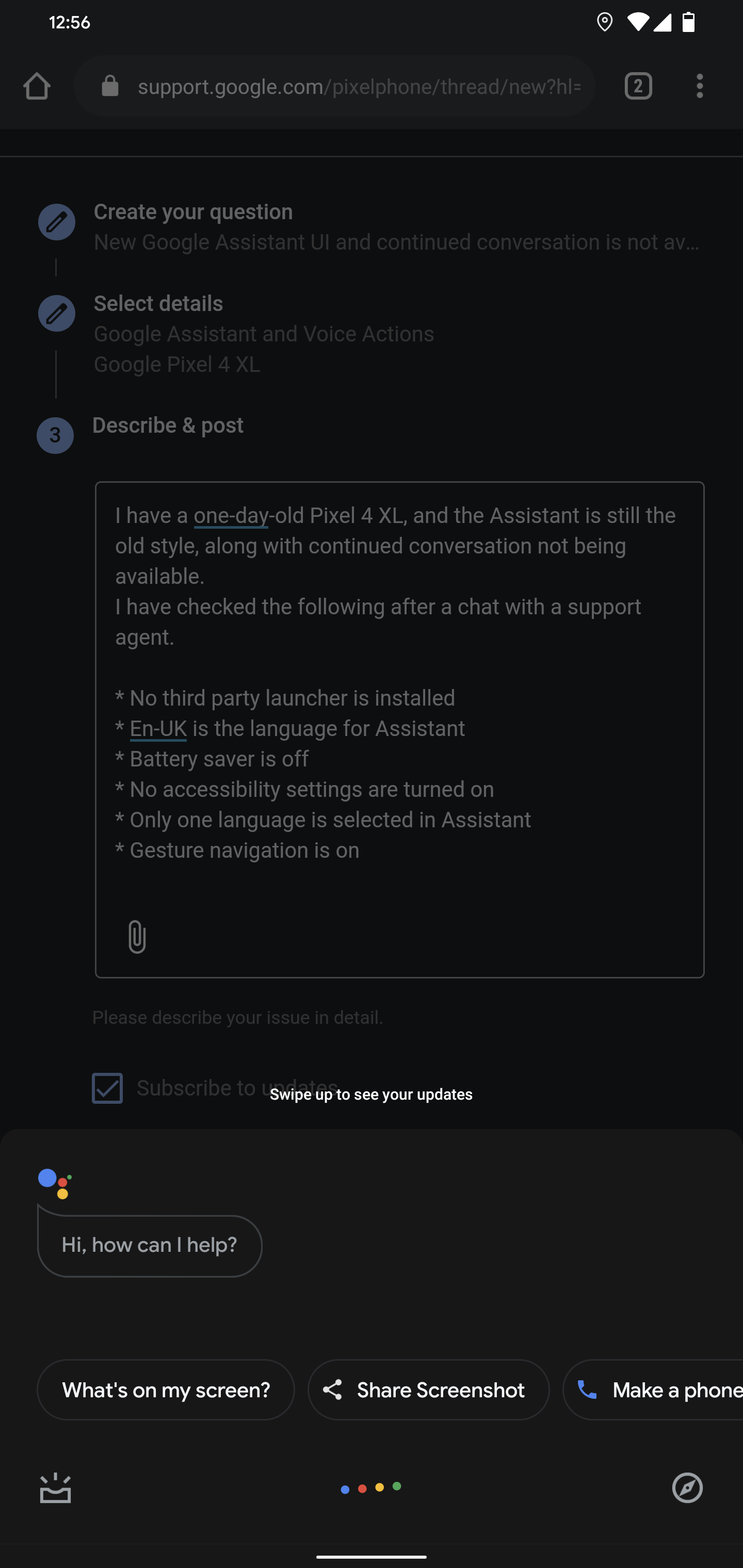
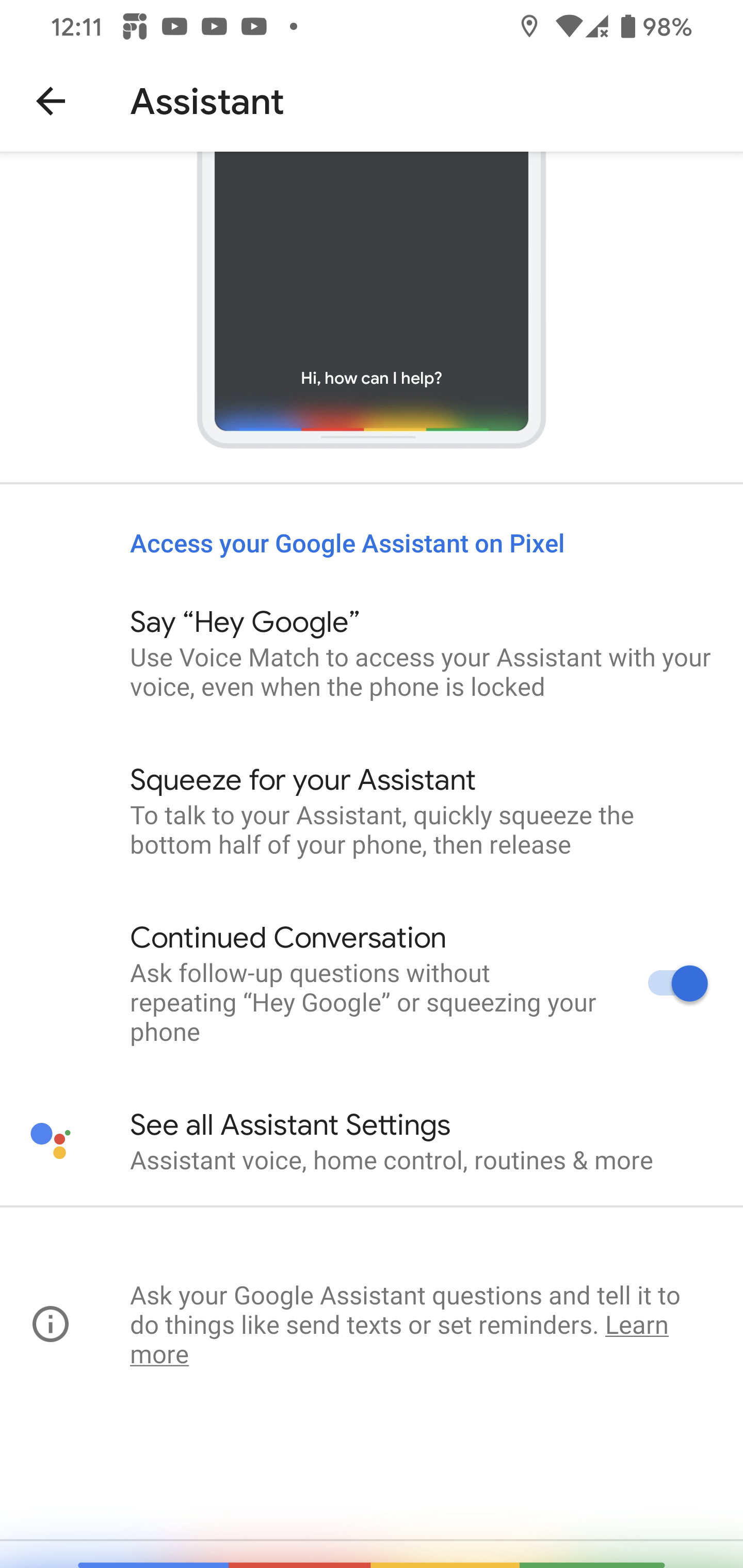
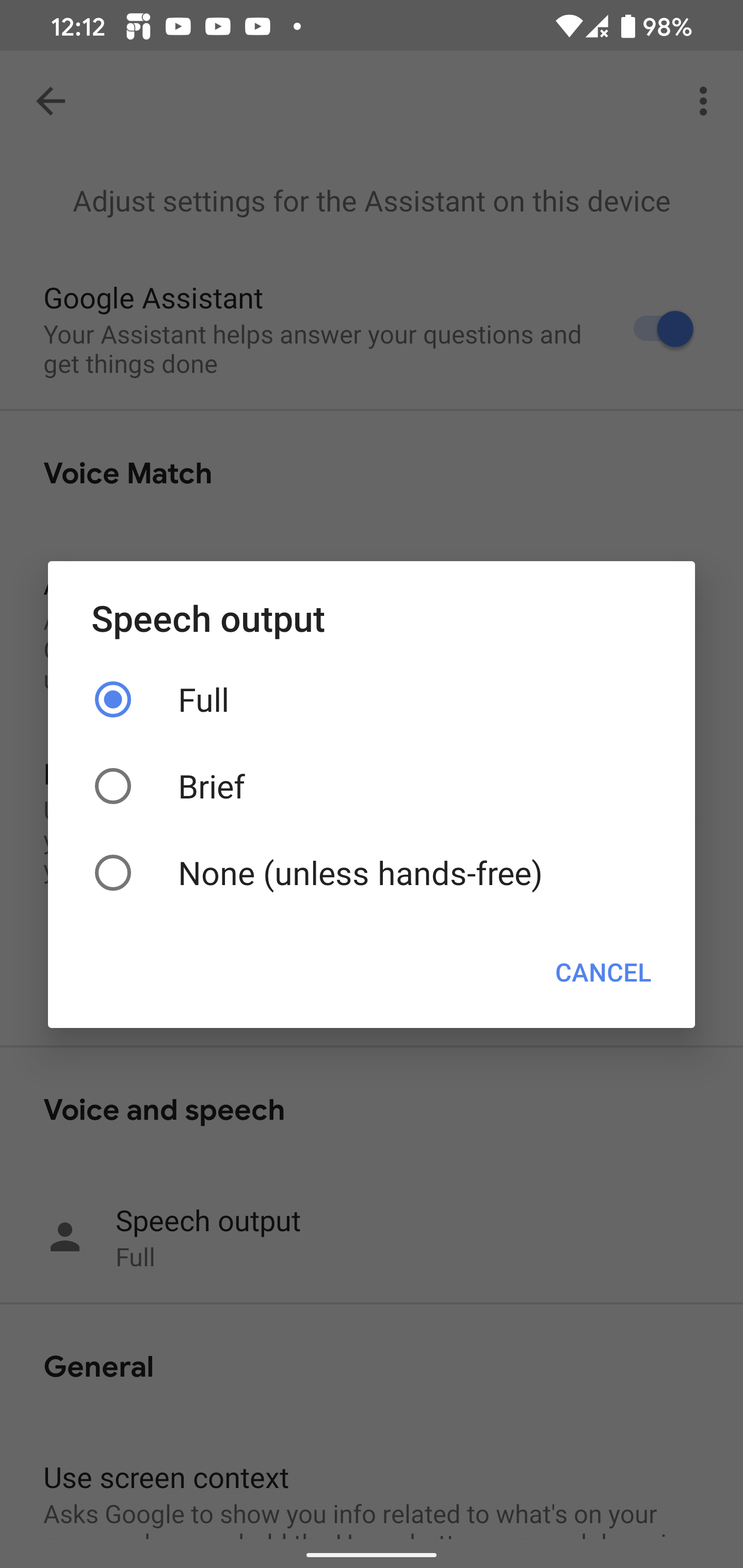
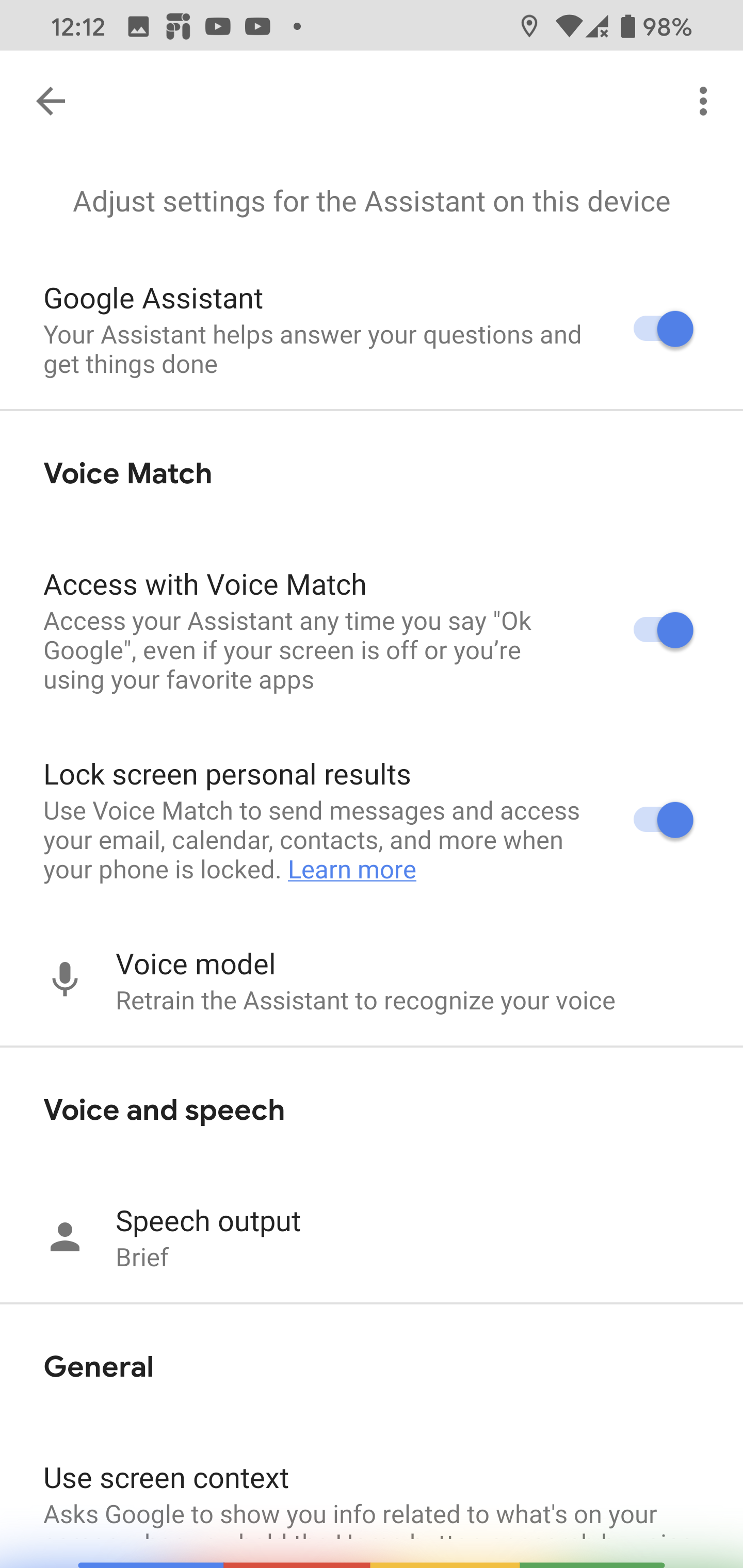
Serial number: 98241FFBA00ACL
Description: PLEASE READ And HELP I've tried MANY TIMES to tell my GOOGLE PIXEL 4 XL "hey Google, call Kurt on speaker". I have also told it "ok Google, call Kurt on speakerphone" and it doesn't work. Very frustrating. IT DOESN'T WORK YET IT WOULD WORK FOR MY GOOGLE PIXEL 2016 EVERY TIME. Now it opens the call and doesn't turn on speaker and I see a message at the bottom that says "assistant can't start when another app is using the microphone". I click end call and on my home screen, I see that the assistant is open on the bottom but the microphone isn't listening. GOOGLE SUPPORT DIDN'T HELP AT ALL!! I'm completely at a loss at what to do now! Tried screen sharing my device with Google support, factory data resetting, clearing the cache for phone and Google app (as instructed) uninstalling app updates and retraining voice model as well. NOTHING. Please help!
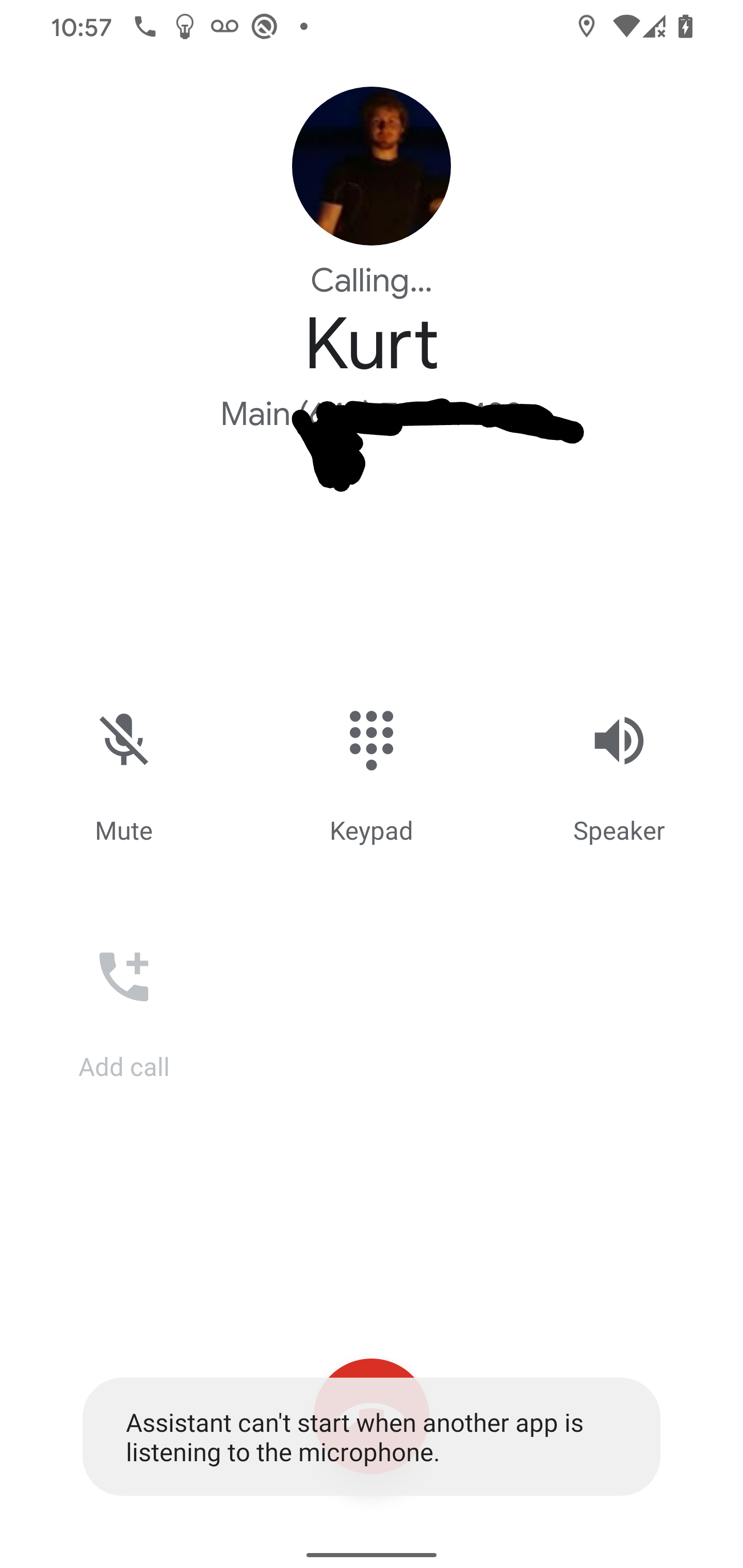 They also can't help me figure out apparently what other app is listening to the microphone.
They also can't help me figure out apparently what other app is listening to the microphone.OpenScape Business

OpenScape Business is the award winning, modern and innovative all-in-one communication solution (PABX) for Unified Communication & Collaboration, specially tailored to the requirements of small and medium sized enterprises with one or more locations.
With the new OpenScape Business V3 and its technology upgrade we make the system future-proof and ready for further requirements, innovations and security demands.

OpenScape Business offers the following highlights:
- Best in Class and Award winning Voice & UC Solution for SMB
- Scalable from 2-2000 Users for Standalone and Multisite environments
- All-In-One Solution incl. feature rich Voice, Presence, Conferencing, Contact Center, Messaging, IM, Mobility, Fax
- Support of any given end-customer infrastructure (on-premise, hybrid, private cloud) incl.comprehensive virtualization-options for Voice & UC
- Easy-to-order & pre-packaged, easy-to-install
- Software Upgrades and Service included for 3 or 5 years (Product Support at least until 2030)
- Ready for new All-IP / ITSP based Services (SIP Provider)
- Connectivity with CIRCUIT (WebRTC) combining powerful enterprise telephony and collaboration services such as Video, Conversations, Screenshare, Fileshare,etc. into a single solution design
Overview
OpenScape Business offers small and medium-sized enterprises everything they need for their individual and diverse communication requirements, unified in a single flexible and scalable solution. The OpenScape Business architecture allows use independently of the existing telephony infrastructure regardless of whether this is classic telephony, IP or DECT. From powerful telephony to a feature-rich set Unified Communication (UC) solution, OpenScape Business always provides with the right solution. With Circuit, the Unify cloud-based WebRTC solution connected to OpenScape Business, customers experience hin teams can easily be considerably improved.
As standalone system up to 1500 subscribers and in networked systems up to 2000 subscribers can be connected.
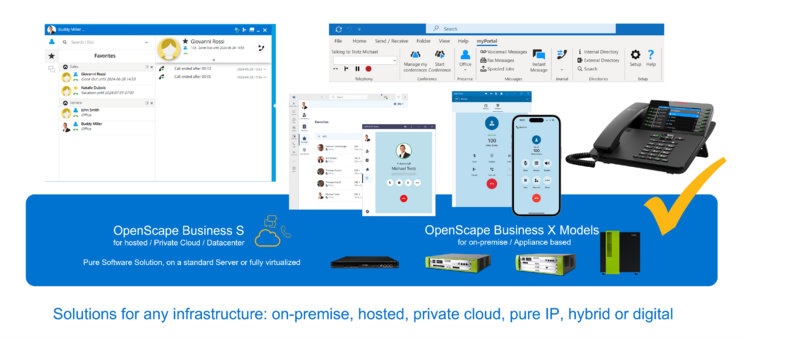
New Features
Since market introduction the feature set of OpenScape Businsse has been continuously enhanced and improved.
The following link contains an overview about the SW versions and the enhancements.
OpenScape Business Feature Enhancements
OpenScape Business Models
Different models are available for the use of telephony and UC functionality.
Hardware Platforms
OpenScape Business X1, X3, X5 or X8 are "All-In-One" HW platforms with onboard IP access and support for up to 500 subscribers with IP, digital (UP0E), ISDN (BRI), analog (a/b), cordless (DECT) devices. UC Smart application is fully embedded. With the new OpenScape Business X8 V3 Mainboard (OCCLA) full UC capabilities and applications are embedded. Connection to public WAN is done via SIP (LAN), ISDN (BRI and PRI) or analog trunks.
UC Booster Platforms
Two UC Booster options are available for OpenScape Business X3/X5 or X8:
- OpenScape Business UC Booster Card is a Plug-In module for OpenScape Busness X3,X5 and X8. It is required for the UC Suite solution up to 150 UC users
- OpenScape Business UC Booster Server is required for OpenScape Business X3/X5/X8 in case of of more than 150 UC users. The UC Booster Server is based on Linux (Novell SLES) and can be operated either on a server HW directly or in vitualized environment using VMware vSphere, Microsoft Hypervisor or KVM.
- With the new OpenScape Business V3 Mainboard (OCCLA) for X8, UC applications are already embedded without the need of additional UC Booster Hardware
By using the UC Booster options the X3R, X5R and X8 models also can be enhanced with the following functions:
- Open Directory Service (connect external directories, such as LDAP or ODBC)
- CSTA interface for connecting external applications
Software Platforms
OpenScape Business S is the server-based "All-In-One" telefony and UC platform, which supports up to 1500 IP subscribers and IP (SIP) connection to the public network (WAN). It is designed for Linux (Novell SLES) operating system and can be operated either on a physical or on virtual machines with VMware vSphere, Microsoft Hypervisor or KVM. OpenScape Business S can be networked with OpenScape Business X1, X3, X5 or X8 as gateway for ISDN or anlog trunks or TDM / analog devices.
Features
OpenScape Business offers a unified software solution architecture based on modern and innovative communication technologies.
- All-In-One Unified Communication solution for small and medium enterprises
- Integrated voice services
- Presence management (presence status)
- Status based call forwarding
- Call Journal
- Favorites list
- Dialing by mouse click
- Visual voicemail
- Drag and Drop Conference
- Directory access with database connection
- Mobility support
- Fax support
- Integration into business processes
- Instant Messaging (IM)
- etc.
- Multichannel Contact Center
- Integration of OpenScape Web Collaboration (Video Conferencing, Screenshare, File Upload)
- Connectivity to Circuit
- Multiple Sites support
- Unified solution architecture
- Scalable and flexible HW / SW and licensing
- Easy to handle migration from HiPath 3000 to OpenScape Business (System box and almost all existing devices can be reused only the motherboard and the SW has to be replaced)
For detailed feature descriptions have a look into the OpenScape Business datasheet or feature description Documentation.
Voice features
- Making calls: Setting up a connection, e.g., via speed dialing or directories
- Call Signaling, Calling Line ID: CLIP, CLIR, COLP und COLR.
- Functions during the call: Holding, redirecting and transferring calls
- Controlling availability: Call forwarding and call forwarding - no answer
- Conferencing: Different types of application-controlled and phone-controlled conferences
- Optimizing communication: Handling calls more efficiently and sending texts to internal subscribers
- Easy Operation: Resetting activated features, Direct Inward System Access (DISA) and multilingual text output
- Working in a team (groups): Multiple subscribers and phones can be reached under one station number
- UCD (Uniform Call Distribution): Uniform distribution of incoming calls to a group of subscribers (UCD group).
- Emergency Calls: Hotline/Hotline after timeout or an emergency service
- etc.
Supported phones and devices
- OpenStage phones (IP/HFA, SIP and T)
- OpenScape Desk Phone (IP,/HFA, SIP)
- OpenStage Key Modules
- Cordless CMI/DECT - IP/DECT telephones
- PC Clients (HFA, SIP)
- OpenScape Personal Edition (including Video support for SIP)
- OpenScape Personal Edition (including Video support for SIP)
- SIP phones (UC Suite) / AP adapter
- SIP phones with RFC 3725 support.
- Mediatrix 4102S (for connecting 2 Analog phones or G.3 FAX devices)
- SIP phones with RFC 3725 support.
More information about supported features of SIP phones and their configurations are available could be found by reading Features and Configuration of SIP Devices page.
Please note:
Devices, which are no longer part of the current product portfolio of Unify, (such as optiPoint 410/420/500; Gigaset Handsets: SL3/S4/M2; OpenStage 5/20/80) can still be connected and operated with OpenScape Business. In case of technical problem no support is given by Unify if the milestone "End od Support" has been reached. For further details such as the required software versions for each device, refer to the respective technical release notes. Optiset E devices cannot be operated in general.
Unified Communications
OpenScape Business provides two alternativ flavours of Unified Communications, depending on the needs:
UC Smart
UC Smart SW is fully embedded within the OpenScape Business SW running either on the motherboard of OpenScape Business X3/X5 and X8 or on the UC Booster. It comprises the following Unified Communications and Collaborations features.
- Presence incl. status based announcements
- Conference planned/adhoc
- Favorites List incl. Call Status
- Directories
- Call Journals incl. Reminder
- Status based Call Forwarding
- Call Control (CTI) incl. dialing by hotkey
- Visual VoiceMail Control
- Instant Messaging (Chat)
- Web Collaborationt
The UC Smart solution offers two clients:
- myPortal Smart
- myPortal to go
UC Suite
UC Suite comprises extensive functions for such as:
- Presence incl. status based announcements
- Conference planned/adhoc
- Favorites List incl. Call Status
- Directories, opt. with ext. database connection
- Call Journals incl. reminder
- Status based Call Forwarding
- CallMe!
- Personal Auto Attendant
- Call Control (CTI) incl. dialing by mouse click or hotkey
- Voice Message Box
- Fax Message Box
- Notifications
- Instant Messaging (Chat)
- Voice Recording
- Multichannel Contact Center
- Web Collaboration
Operation of UC Suite in combination with OpenScape Business X models requires either the new OpenScape Business X8 V3 Mainboard (OCCLA), UC Booster Card or the UC Booster Server, in case of extended number of Unified Communications users. No additional UC Booster HW is required in case of OpenScape Business S.
The UC Suite solution offers several Unified Communbications clients:
- myPortal for Desktop
- myPortal for Outlook as Add On for Microsoft Outlook
- myAttendant
- myPortal to go
Multichannel Contact Center
The Multichannel Contact Center option is available for OpenScape Business UC Suite.
The embedded Contact Center solution offers two clients for use within the contact center environment:
- myAgent as agent and supervisor desktop application
- myReports as client for report creation
The features of the Contact Center are described within the following document:
The following tutorials contain specific contact center configuration advices:
Note:
The information provided in these documents contains merely general descriptions or characteristics of performance which in case of actual use do not always apply as described or which may change as a result of further development of the products.
Mobility options for mobile employees
OpenScape Business offers embedded mobility services and solutions for any enterprise. These comprise:
- Integration of smartphones of mobile workers
- Support of cordless and WLAN telephones within the office
- DeskSharing solution
- Teleworking solution
OpenScape Business Mobility provides features like:
- Smartphone and tablet PC integation into UC solution
- One Number Service regardless of location and used device
- Dual mode telephony (UMTS / WLAN) support at public hotspots
- Mobile Logon
- CallMe function
- VPN support
- etc.
OpenScape Business clients
| Solution | Client | Recommended | for | Remarks |
| UC Smart | UC Suite | |||
| UC | myPortal Smart | x | UC-Desktop-Client | |
| myPortal for Desktop | x | Enhanced UC-Desktop-Client | ||
| myPortal for Outlook | x | UC-Outlook-Integration | ||
| myPortal to go | x | x | Mobility-Client for Smartphones / Tablets either as App or Web-based | |
| myPortal @work | x | x | Common Client for UC Smart and UC Suite incl. VoIP functionality | |
| Attendant | OpenScape Business Attendant | x | x | Attendant optional with UC presence |
| myAttendant | x | UC Attendant | ||
| Company Auto Attendant | x | x | Slightly different featureset within UC Smart and UC Suite | |
| Contact Center | myAgent | x | Contact Center Client | |
| myReports | x | myReports can also be used for Contact Center independent UC user reports | ||
myPortal @work
is the common UC desktop client for the UC Smart and UC Suite solution.
- is available for Microsoft Windows and Apple MAC OS.
- manages and shows presence status of contacts, set connection control of your office extension, and access to directories, favorites, voicemail and journals.
- offers an integrated WebRTC based VoIP client as an option.
Additional information can be found within this Wiki using the following link:
myPortal @work
myPortal for Desktop
presents the full suite of OpenScape Business UC features from a single window
Additional information can be found within this Wiki using the following links:
myPortal for Desktop
myPortal for Outlook
- all of the functionality in myPortal for Desktop available as an MS Outlook toolbar!
- enables users to access all of their communications - voice, conferencing, voicemail, fax, IM, email, and contacts - directly from within MS Outlook
- Users can click to dial any number from any Microsoft application
Additional information can be found within this Wiki using the following link:
myPortal for Outlook
myPortal to go
- delivers OpenScape Business UC features onto your Smartphone or Tablet PC
- manages and shows presence status of contacts, set connection control of your office extension, and access to directories, favorites, voicemail and journals.
- offers an integrated VoIP (HFA)client as an option within the App version.
Additional information can be found within this Wiki using the following link:
myPortal to go
myAttendant
- presence-aware switchboard application used by administrators, dispatchers or supervisor
- presents a single, consolidated view of all of the company’s users and their presence status, making it easy to transfer calls to employees when they are available
Additional information can be found within this Wiki using the following link:
myAttendant
myAgent
Presents the full suite of contact center features from a single desktop view (call queue information, relevant customer information pop-ups accompany incoming calls, access customer data and call history)
Additional information can be found within this Wiki using the following link:
myAgent
myReports
myReports provides over 100 predefined standard reports. The historical reports are provided as graphs and/or table views.
Additional information can be found within this Wiki using the following link:
myReports
Embedded applications
OpenScape Business provides some embedded applications, which are running optionally within the OpenScape Business system.
OpenStage Gate View
OpenStage Gate View is a user-friendly, security solution that offers real-time video surveillance to observe, control and grant access to entrance areas all from your OpenStage Business phone, PC or your Smart Phone.
IP-capable video cameras send video streams to the OpenScape Business, which enables authorized Gate View users to display this video streams. The video image associated with an activated entrance telephone (door opener) can be automatically displayed on an assigned OpenStage phone. In addition the video can also be displayed on mobile devices by using the web client or in case of Apple´s iPhone using the appropriate App.
OpenStage GateView supports also scheduled recording of a video stream and the saving of recordings to a network drive.
Suiteable video cameras are not included in the ordering process Depending on the customer's requirements (e.g., LAN, WLAN, indoor/outdoor, PoE), cameras can be purchased on the open market. Instructions on integrating user-defined cameras together with a list of certified cameras as well as the technical specifications can be found at:
OpenStage Gate View FAQ.
Administration of Gate View is done via the administration portal of OpenScape Business.
As a prerequisite a UC Booster Card or OC Booster Server is required for OpenScape Buisness. Capacities of Gatev View in terms of number supported cameras and phones etc. depends on the choosen UC Booster HW. Details are described within the administration manual.
The use of Gate View is licensed controlled.
General configuration
Single Node
Networked System
Networking "OpenScape Business" OpenScape Business offers the opportunity to build networks with up to 2000 participants. Within an OpenScape Business Network a broad range Unfified communcation feature are available for all useres beneath the normal telephony features e.g:
- Presence management with voice support(visibility of presence status)
- Network-wide call status (e.g. subscriber is being called, subscriber has an active call)
- Call pickup via myPortal for Desktop
- Instant messaging with Multi-User-Chat
- Drag&Drop conferences in the network
- Network-wide Web Collaboration (for example, desktop sharing and video)
- myAttendant – change the presence status for all users in the network
- Integrate external directories with OpenScape Office Directory Services
- Integration in the Microsoft Exchange calendar and in the public directory
- Forwarding of voicemails in the network
- Support of XMPP presence & chat with external partners
An OpenScape Business network is controlled by the so called Master Node, which does not require necessarily additional HW/SW depending on the size of the network. An administrator can access all network subscribers via the Single Point of Administration within the Master Node. When changes are made within the Master Node administration, the databases of the individual network nodes are automatically synchronized.
A LAN/WAN based IP network is required as prerequisite for networking. OpenScape Business systems can be networked with one another also via digital trunks. Both S0 as well as S2M lines with QSIG protocol can be used for the connection.
Within the following some essentiall networking scenarios are shown. Details, prerequisites and even more scenarios are decribed within the administration manual of OpenScape Business Documentation.
Networking Multiple OpenScape Business X1/X3/X5/X8 Systems
Up to 32 OpenScape Business communication systems can be networked with each other.
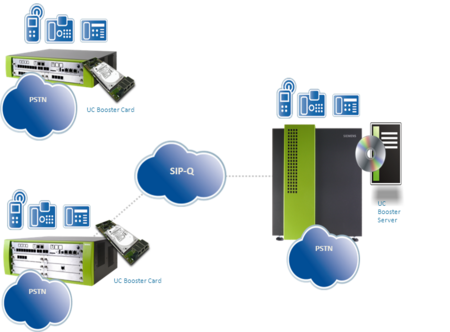
Networking OpenScape Business and OpenScape Business S (Single Gateway)
Up to 32 OpenScape Business X1/X3/X5/X8 and S communication systems can be networked with one another. Multiple OpenScape Business S systems are allowed in an internetwork. Single Gateway means that all IP stations registered at OpenScape Business S only use ONE gateway to the PSTN.
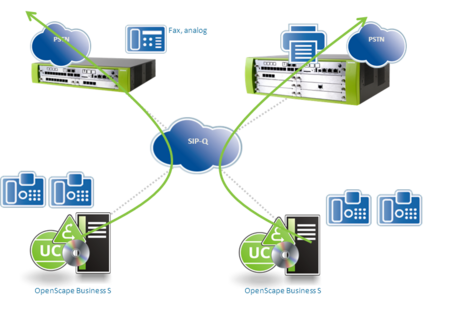
Networking OpenScape Business and OpenScape Business S (Multi Gateway)
Up to 32 OpenScape Business X1/X3/X5/X8 andS communication systems can be networked with one another. Multi-gateway means that every IP station registered at OpenScape Business S is assigned to exactly one specific gateway.
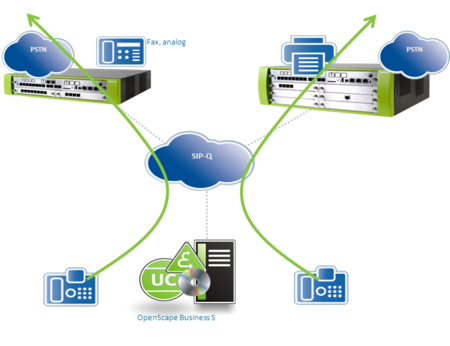
Data Center and Cloud Deployments
SIP / ITSP Connectivity
Configuration of LAN/WAN interface for VoIP
SIP Devices
Information about connection of and SIP devices can be found within the following link
SIP Trunks and certified ITSP
Information about connection of SIP trunks and certified VoIP service providers can be found within the following link
Integrated Session Border Controller
Miscellaneous SIP related topics
Integration in business application and processes
OpenScape Business supports many interfaces, protocols and standards for integration into business process or connection to 3rd party applications. Details are listed in the the datasheet or feature description. Within the following section only the most relevant interfaces and integrations are described. Nearly all connections, except TDM telefony, uses the Ethernet LAN interface of OpenScape Business.
Windows Terminal Server and Citrix support
The following document describes how to operate OpenScape Business client within Windows Remote Desktop Services and Citrix XenApp environment
Microsoft Exchange Server
The following documents describe how to connect OpenScape Business to “Microsoft Exchange"
Microsoft Office 365
The following document describes how to connect a local OpenScape Business to “Microsoft Office 365”
Access to external directories and data sources
OpenScape Business can access data within external directories or databases via:
- Open Directory Service
- LDAP
- Data replication via CSV file import
Open Directory Service
is fully embedded within OpenScape business. It allows access to internal User Data, Speed Dials and the UC-Suite Directory as well as to following external SQL database servers:
- Microsoft SQL server,
- Postgres SQL server,
- Sybase SQL server
More information is given within the link:
LDAP - Lightweigt Data Access Protocol allows direct data querey from external LDAP capable directories.
The administration of the LDAP interface within OpenScape Business is described within the link:
Open Interfaces
Information about OpenScape Business and its interfaces for business process integration can be found here
CTI - Computer Telephony Integration
OpenScape Business offers several protocols and API´s to application programmers to integrate telephony and UC functions of OpenScape Business into their applications.
Interface Description
The descriptions of the CTI interfaces are provided within the following link:
TAPI Service Provider
Due to the importance of TAPI two new and powerful TAPI Service Providers (TSP) have been developed for OpenScape Business in addition to the existing CallBridge Collection.
Differences between OSBiz TAPI 120/170 and HiPath TAPI 120/170
In contrast to the handling of the HiPath TAPI 120/170 V2 TAPI Service Providers for HiPath 3000, the following changes apply in the OpenScape Business environment:
- OpenScape Business TAPI 120 and TAPI 170 are new software components that were developed exclusively for OpenScape Business. The software versioning begins with Version 1.
- The OpenScape Business TAPI 120 or 170 software and the licenses can only be used in conjunction with OpenScape Business.
- The connection to OpenScape Business takes place exclusively via the LAN.
- Additional hardware and software components such as the CSTA Message Dispatcher (CMD), CSTA Service Provider (CSP), HG 1500 board or HiPath 5000 RSM System are no longer required for OpenScape Business TAPI 120/170.
- The licensing is station based and no longer distinguishes between OpenScape Business TAPI 120 or TAPI 170 stations. The licensing requirement begins with the first TAPI station.
- Existing HiPath TAPI 120 or 170 user licenses cannot be used in conjunction with OpenScape Business TAPI 120 or 170
Device@Home
System(HFA)Device@Home
The feature "System Device @ Home" allows the connection of system telephones as OpenStage or OpenScape Deskphone with HFA protocol over the Internet to OpenScape Business and as to operate them e.g. in the home office.
SIP Device@Home
OpenScape Business supports the STUN protocol (Session Traversal Utilities for NAT). This enables the connectivity of STUN capable SIP devices to OpenScape Business via the Internet.
Integration of Vertical Solutions
Hotel / Hospitality Solutions
OpenScape Business can be connected to Hospitality Solutions. On Overview about Hospitality Solutions in general and theit connectivity to OpenScape Business is shown within the following link.
Circuit
This section describes the OpenScape Business to Circuit Connectivity and how this can be configured. More informations about Circuit can be found Circuit
MS Skype for Business Interworking
This section describes the Telephony Voice Interworking capabilities between OpenScape Business and MS Microsoft Skype for Business an how this can be configured
MS Teams Interworking
This section describes the Telephony Voice Interworking capabilities between OpenScape Business and MS Teams (Direct Routing Plan via SBC) based on customer experiences
Capacities
| OpenScape Business X1 | OpenScape Business X3 | OpenScape Business X5 | OpenScape Business X8 | OpenScape Business S | |
|---|---|---|---|---|---|
| BRI Trunks | 4 | 20 | 52 | 128 | N/A |
| PRI Trunks | 0 | 0 | 30 | 180 | N/A |
| ITSP Trunks | 30 | 60 | 60 | 60 | 180 |
| Analog Stations | 4 | 20 Rack system 20 Wall system | 56 Rack system 68 Wall system | 384 | N/A |
| Digital Phones | 8 | 24 | 56 | 384 | N/A |
| IP Phones | 20 | 500 | 500 | 500 | 1500 |
| Cordless/DECT Phones | 16 | 32 | 32 Rack system 64 Wall system | 250 | N/A |
| Max.# of Phones | 30 | 500 | 500 | 500 | 1500 |
Remarks: Figures are subject to change. For actual figures refer to the latest version of OpenScape Business Sales Information and Datasheet.
Administration
Administration of OpenScape Business is done mainly via Web Based Management (OpenScape Business Assistant). Manager E tool, known from HiPath 3000, can also be used for administration alternatively.
Documentation
Documentation is available from different sources depending on the type of documentation.
Main source for technical documentation and user guides is the OpenScape Business systems itself. Documents are available either as download from the system SW via the administration tool or can be accessed direcly as file on the SW storage media.
All available documents can be obtained via the Partner Portal.
The following table gives an overview about the provided documents.
| Target Group | Documentation | Content | Medium | Source of supply |
| Sales and Project Planners | Data Sheet | System Overview | e-Docu | Partner Portal |
| Feature Description | This document describes all features | e-Docu | Partner Portal | |
| Planning Guide | This document provides guidelines for planning | e-Docu | Partner Portal | |
| Administrators and Technicians | Installing the Hardware, Service Documentation | This document describes the hardware for OpenScape Business X3/X5/X8 (including the hardware installation) | e-Docu | Partner Portal |
| Installing OpenScape Business X3/X5/X8 | This document describes the installation of OpenScape Business X3/X5/X8 | e-Docu | Partner Portal | |
| Installing the Linux Server | The document describes how to install Linux on a separate server PC as a platform for the OpenScape Business S Softswitch and the Application Server OpenScape Business UC Booster Server | e-Docu | Partner Portal | |
| Installing OpenScape Business S | This document describes the installation of the communication software for the OpenScape Business S Softswitch (incl. UC Suite) on a separate Linux server | e-Docu | Partner Portal | |
| Installing the OpenScape Business UC Booster Server | This document describes the installation of the communication software for the Application Server OpenScape Business UC Booster Server (incl. UC Suite) on a separate Linux server | e-Docu | Partner Portal | |
| Administrator Documentation | This document describes the installation, configuration, operation, administration and features of OpenScape Business | e-Docu | System, Partner Portal | |
| Manager E, Administrator Documentation | This document describes the configuration of features using Manager E | e-Docu | Partner Portal | |
| Users, Technicians, Administrators | myPortal Smart, User Guide | This document describes the configuration and operation of the myPortal Smart application | e-Docu | System, Partner Portal |
| myPortal for OpenStage, User Guide | This document describes the configuration and operation of myPortal for OpenStage | e-Docu | System, Partner Portal | |
| myPortal for Desktop, User Guide | This document describes the installation, configuration and operation of the myPortal for Desktop application | e-Docu | System, Partner Portal | |
| myPortal for Outlook, User Guide | This document describes the installation, configuration and operation of the myPortal for Outlook application | e-Docu | System, Partner Portal | |
| Fax Printer, User Guide | This document describes the installation, configuration and operation of Fax Printer | e-Docu | System, Partner Portal | |
| myPortal to go, User Guide | This document describes the configuration and operation of myPortal for Mobile | e-Docu | System, Partner Portal | |
| myAgent, User Guide | This document describes the installation, configuration and operation of the myAgent application | e-Docu | System, Partner Portal | |
| myReports, User Guide | This document describes the installation, configuration and operation of the myReports application | e-Docu | System, Partner Portal | |
| myAttendant, User Guide | This document describes the installation, configuration and operation of the myAttendant attendant console | e-Docu | System, Partner Portal | |
| OpenScape Business Attendant, User Guide | This document describes the installation, configuration and operation of the attendant console OpenScape Business Attendant | e-Docu | System, Partner Portal | |
| UC Smart Telephone User Interface (TUI), Quick Reference Guide | This document describes the phone menus of the voicemail box (UC Smart) | e-Docu | System, Partner Portal | |
| UC Suite Telephone User Interface (TUI), Quick Reference Guide | This document describes the phone menu of the voicemail box (UC Suite) | e-Docu | System, Partner Portal | |
Software Delivery / Deployment
SW deployment depends on the OpenScape Business models. SW is either deployed as embedded SW or has to be ordered separately on a storage media. SW corrections are available at the Central Software Download Server of Unify, which can be accessed via the Partner Portal.
OpenScape Business X models The SW of OpenScape Business X models is delivered on a SDHC card together with the main board. SW needs not be ordered separately. In case that a UC Booster Card is required the SW is delivered on its internal storage device.
OpenScape Business UC Booster Server or OpenScape Business S The SW of OpenScape Business Booster Server or OpenScape Business S has to be ordered separately. The SW is delivered on DVD as data media.
The required operating system (Suse Linux Enterprise system (SLES)) can be obtained also from Unify.
In case, that the SLES SW is ordered from Unify, an registration key for a 3 year SW update period, granted by Novell, is included.
OpenScape Business S SW (incl. SLES) is also available as .OVA Image for virtualized machines via the software Supply Server.
Licensing
Use of OpenScape Business features is licensed. Starting with the basic system licence, additional features can be easily added, by importing appropriate license keys. License keys are providedby the Central License Server order dependent and are managed by the administration tools of OpenScape Buisness.
Activation Period
OpenScape Business supports a Licence Activation Period with full feature functionality for a time period of 30 days after first installation. After 30 days system functionality is restricted to emergency operation in case that no valid license keys have been uploaded to the system.
Evaluation Licenses
If specific functions should be tested for a time period of 90 days, so called Evaluation Licenses can be ordered.
Migration
OpenScape Business offers an easy migration path from HiPath 3000 to OpenScape Business.
Depending on the HW / SW version of HiPath 3000 existing housing, power supply and also many peripherial boards and devices can be reused.
Within many migration cases only the mainboard, System SW and license file need to be replaced by OpenScape Business components.
Conversion of system configuration data is also supported.
Details are described within the OpenScape Business Sales Information and the Administration Manual
Security
Security Checklist
Instructions for hardening of OpenScape Business are described within the
OpenScapeBusiness Security Checklist
which can be downloaded from the Partner Portal.
Security Bulletins
The following documents contain descriptions of security improvements.
Discontinued Applications
Up from OpenScape Business V3 the following applications will be discontinued and be replaced by successor solutions. More informations can be found in the current OpenScape Business Sales Information within our UNIFY Partner Portal
Further Technical Information / Links
Supported Standards
Ethernet
- RFC 894 Ethernet II Encapsulation
- IEEE 802.1Q Virtual LANs
- IEEE 802.2 Logical Link Control
- IEEE 802.3u 100BASE-T
- IEEE 802.3ab Gigabit Ethernet
- IEEE 802.3X Full Duplex Operation
IP/Routing
- RFC 768 UDP
- RFC 791 IP (updated by: RFC 1349, RFC 2474, RFC 6864)
- RFC 792 ICMP (updated by: RFC 950, RFC 4884, RFC 6633, RFC 6918)
- RFC 793 TCP (updated by: RFC 1122, RFC 3168, RFC 6093, RFC 6528)
- RFC 826 ARP (updated by: RFC 5227, RFC 5494)
- RFC 1332 The PPP Internet Protocol (updated by: RFC 3241)
- RFC 1918 IP Addressing (updated by: RFC 6761)
- RFC 2131 DHCP (updated by: RFC 3396, RFC 4361, RFC 5494, RFC 6842)
- RFC 2822 Internet Message Format (obsoleted by RFC 5322)
- RFC 5322 Internet Message Format (updated by: RFC 6531, RFC 6532, RFC 6854)
Control Protocol (IPCP)
- RFC 1334 PPP Authentication Protocols (obsoleted by: RFC 1994)
- RFC 1618 PPP over ISDN
- RFC 1661 The Point-to-Point Protocol (PPP) (updated by: RFC 2153)
- RFC 1877 PPP Internet Protocol Control Protocol
- RFC 1990 The PPP Multilink Protocol (MP)
- RFC 1994 PPP Challenge Handshake Authentication Protocol (CHAP) (updated by: RFC 2484)
- RFC 2516 A Method for Transmitting PPP Over Ethernet (PPPoE)
- RFC 3544 IP Header Compression over PPP
NAT
IPsec
- RFC 2403 IPsec Authentication - MD5
- RFC 2404 IPsec Authentication - SHA-1
- RFC 2404 IPsec Authentication - SHA-2
- RFC 2405 IPsec Encryption 3DES
- RFC 2407 IPsec DOI
- RFC 2408 ISAKMP
- RFC 2409 IKE
- RFC 2410 IPsec encryption - NULL
- RFC 2411 IP Security Document Roadmap
- RFC 2412 OAKLEY
- RFC 3602 IPSec encryption with AES
- RFC 4301 Security Architecture for the IP
- RFC 4303 IP Encapsulating Security Payload (ESP)
SNMP
QoS
- IEEE 802.1p Priority Tagging
- RFC 1349 Type of Service in the IP Suite (obsoleted by: RFC 2474)
- RFC 2474 Type of Service in the IP Suite (updated by: RFC 3168, RFC 3260)
- RFC 2475 An Architecture for Differentiated Services (updated by: RFC 3260)
- RFC 2597 Assured Forwarding PHB Group (updated by: RFC 3260)
- RFC 3246 An Expedited Forwarding PHB (Per-Hop Behavior)
Services
- RFC 2597 Assured Forwarding PHB Group
- RFC 3246 An Expedited Forwarding PHB (Per-Hop Behavior)
Codecs
CTI
- CSTA Phase III
- TAPI Service Provider for TAPI 2.1
SIP
The table below indicates which RFCs are implemented on the SIP interfaces of the system:
- ITSP: Internet Telephony Service Provider interface
- SIP SUB: SIP interface for connection of SIP- phones
- SIP TRK: SIP interface for connection to external SIP servers
- SIP-Q: SIP interface for connection of OpenScape Business systems
Within the SIP interface columns following information are given:
- yes: The main content of the RFC is implemented in the system. There might be options in the RFC which are not implemented. No details are given in the list
- no RFC is NOT implemented on that interface
- n/a RFC is not applicable to that interface
The information applies to OpenScape Business Version V2R3
| RFC number | Title | Remarks | ITSP | SIP-SUB | SIP-TRK | SIPQ |
| RFC 1889 | RTP: A Transport Protocol for Real-Time Applications | Obsoleted by RFC3550 | yes | yes | yes | yes |
| RFC 2198 | RTP Payload for Redundant Audio Data | Used in conjunction with RFC 2833 | no | no | no | no |
| RFC 2246 | The TLS Protocol Version 1.0 | Obsoleted by RFC4346, Updated by RFC3546 | no | no | no | no |
| RFC 2327 | SDP: Session Description Protocol (obsoleted by RFC4566) | yes | yes | yes | yes | |
| RFC 2396 | Uniform Resource Identifiers (URI): Generic Syntax | Obsoleted by RFC3986 | yes | yes | yes | yes |
| RFC 2560 | X.509 Internet Public Key Infrastructure Online Certificate Status Protocol - OCSP | no | no | no | no | |
| RFC 2617 | HTTP Authentication: Basic and Digest Access Authentication | yes | yes | no | no | |
| RFC 2782 | DNS RR for specifying the location of services (DNS SRV) | yes | n/a | yes | yes | |
| RFC 2833 | RTP Payload for DTMF Digits, Telephony Tones and Telephony Signals | Obsoleted by 4733 | yes | yes | yes | yes |
| RFC 2976 | The SIP INFO Method | Used for SIPQ trunking only | no | no | no | yes |
| RFC 3204 | MIME media types for ISUP and QSIG Objects | QSIG only | no | no | no | yes |
| RFC 3261 | SIP: Session Initiation Protocol | SIP Core RFC | yes | yes | yes | yes |
| RFC 3262 | Reliability of Provisional Responses in the Session Initiation Protocol (SIP) | provisional Response Acknowledgement (PRACK) Early Media | no | yes | no | no |
| RFC 3263 | SIP Locating Servers | yes | yes | yes | yes | |
| RFC 3264 | An Offer/Answer Model with SDP | yes | yes | yes | yes | |
| RFC 3265 | Session Initiation Protocol (SIP)-Specific Event Notification | used for MWI and GroupPickup | no | yes | no | no |
| RFC 3268 | Advanced Encryption Standard (AES) Cipher suites for Transport Layer Security (TLS) | no | no | no | no | |
| RFC 3280 | Internet X.509 Public Key Infrastructure Certificate and Certificate Revocation List (CRL) Profile | no | no | no | no | |
| RFC 3310 | HTTP Digest Authentication | yes | yes | no | no | |
| RFC 3311 | Session Initiation Protocol (SIP) UPDATE Method | yes | yes | yes | yes | |
| RFC 3312 | Integration of Resource Management and Session Initiation Protocol (SIP) | no | no | no | no | |
| RFC 3323 | A Privacy Mechanism for the Session Initiation Protocol (SIP) | yes | yes | no | no | |
| RFC 3324 | Short Term Requirements for Network Asserted Identity | no | no | no | no | |
| RFC 3325 | Private Extensions to the Session Initiation Protocol (SIP) for Asserted Identity within Trusted Networks | yes | yes | yes | no | |
| RFC 3326 | The Reason Header Field for the Session Initiation Protocol (SIP) | yes | yes | yes | yes | |
| RFC 3327 | Session Initiation Protocol (SIP) Extension Header Field for Registering Non-Adjacent Contacts | no | no | no | no | |
| RFC 3329 | Security Mechanism Agreement for the Session Initiation Protocol | no | no | no | no | |
| RFC 3389 | Real-time Transport Protocol (RTP) Payload for Comfort Noise (CN) | no | no | no | no | |
| RFC 3420 | Internet Media Type message/sipfrag | no | no | no | no | |
| RFC 3428 | Session Initiation Protocol (SIP) Extension for Instant Messaging | no | no | no | no | |
| RFC 3489 | STUN - Simple Traversal of User Datagram Protocol (UDP) Through Network Address Translators (NATs) | yes | yes | no | no | |
| RFC 3515 | The Session Initiation Protocol (SIP) Refer Method | no | yes | no | no | |
| RFC 3550 | RTP: Transport Protocol for Real-Time Applications | yes | yes | yes | yes | |
| RFC 3551 | RTP Profile for Audio and Video Conferences with Minimal Control | yes | yes | yes | yes | |
| RFC 3581 | An Extension to the Session Initiation Protocol (SIP) for Symmetric Response Routing | rport | yes | yes | yes | no |
| RFC 3605 | Real Time Control Protocol (RTCP) attribute in Session Description Protocol (SDP) | no | no | no | no | |
| RFC 3665 | Session Initiation Protocol (SIP) Basic Call Flow Examples | yes | yes | yes | N/A | |
| RFC 3666 | Session Initiation Protocol (SIP) Public Switched Telephone Network (PSTN) Call Flows | yes | yes | yes | N/A | |
| RFC 3680 | A Session Initiation Protocol (SIP) Event Package for Registrations | no | no | no | no | |
| RFC 3711 | The Secure Real-time Transport Protocol (SRTP) | yes | no | no | yes | |
| RFC 3725 | Best Current Practices for Third Party Call Control (3pcc) in the Session Initiation Protocol (SIP) | no | yes | no | no | |
| RFC 3761 | The E.164 to Uniform Resource Identifiers (URI) Dynamic Delegation Discovery System (DDDS) Application (ENUM) | no | no | no | no | |
| RFC 3830 | MIKEY: Multimedia Internet KEYing | MIKEY0 only | no | no | no | yes |
| RFC 3842 | A Message Summary and Message Waiting Indication Event Package for the Session Initiation Protocol (SIP) | no | yes | no | no | |
| RFC 3891 | The Session Initiation Protocol (SIP) Replaces Header | passive usage only | no | yes | no | no |
| RFC 3892 | The Session Initiation Protocol (SIP) Referred-By Mechanism | no | yes | no | no | |
| RFC 3959 | The Early Session Disposition Type for the Session Initiation Protocol (SIP) | no | no | no | no | |
| RFC 3960 | Early Media and Ringing Tone Generation in the Session Initiation Protocol (SIP) | no | no | no | no | |
| RFC 3966 | The tel URI for Telephone Numbers | yes | no | no | no | |
| RFC 3968 | The Internet Assigned Number Authority (IANA) Header Field Parameter Registry for the Session Initiation Protocol (SIP) | As this RFC describes rules for assigning new parameters etc. it is not applicable for a certain product | N/A | N/A | N/A | N/A |
| RFC 3969 | The Internet Assigned Number Authority (IANA) Uniform Resource Identifier (URI) Parameter Registry for the Session Initiation Protocol (SIP) | As this RFC describes rules for assigning new parameters etc. it is not applicable for a certain product | N/A | N/A | N/A | N/A |
| RFC 4040 | RTP Payload Format for a 64 kbit/s Transparent Call | yes | yes | yes | yes | |
| RFC 4028 | Session Timers in the Session Initiation Protocol (SIP) | yes | yes | no | yes | |
| RFC 4119 | A Presence-based GEOPRIV Location Object Format | XML based location definition for emegancy calls | yes | no | no | no |
| RFC 4123 | Session Initiation Protocol (SIP)-H.323 Interworking Requirements | no | no | no | no | |
| RFC 4235 | An INVITE-Initiated Dialog Event Package for the Session Initiation Protocol | Used for GroupPickup | no | yes | no | no |
| RFC 4244 | An Extension to the Session Initiation Protocol (SIP) for Request History Information | no | no | no | no | |
| RFC 4320 | Actions Addressing Identified Issues with the Session Initiation Protocol's (SIP) Non-INVITE Transaction | no | no | no | no | |
| RFC 4504 | SIP Telephony Device Requirements and Configuration | no | no | no | no | |
| RFC 4538 | Request Authorization through Dialog Identification in the Session Initiation Protocol (SIP) | no | no | no | no | |
| RFC 4566 | SDP: Session Description Protocol; M. Handley, V. Jacobson.(obsoletes RFC 2327) | yes | yes | yes | yes | |
| RFC 4568 | Session Description Protocol (SDP) Security Descriptions for Media Streams | yes | no | no | no | |
| RFC 4733 | RTP Payload for DTMF Digits, Telephony Tones, and Telephony Signals | yes | yes | yes | yes | |
| RFC 4856 | Media Type Registration of Payload Formats in the RTP Profile for Audio and Video Conferences | Obsoletes RFC3555 | yes | yes | yes | yes |
| RFC 4967 | Dial String Parameter for the Session Initiation Protocol Uniform Resource Identifier | no | no | no | no | |
| RFC 5009 | Private Header (P-Header) Extension to the Session Initiation Protocol (SIP) for Authorization of Early Media | P-Early-Media header | yes | no | no | no |
| RFC 5031 | A Uniform Resource Name (URN) for Emergency and Other Well-Known Services | no | no | no | no | |
| RFC 5139 | Revised Civic Location Format for Presence Information Data Format Location Object (PIDF-LO) | XML based location definition for emegancy calls | yes | no | no | no |
| RFC 5245 | Interactive Connectivity Establishment (ICE):A Protocol for Network Address Translator (NAT) Traversal for Offer/Answer Protocols | no | no | no | no | |
| RFC 5246 | The Transport Layer Security (TLS) Protocol Version 1.2 | yes | yes | yes | yes | |
| RFC 5280 | Internet X.509 Public Key Infrastructure Certificate and Certificate Revocation List (CRL) Profile | no | no | no | no | |
| RFC 5589 | Session Initiation Protocol Call Control – Transfer | no | yes | no | no | |
| RFC 5806 | Diversion Indication in SIP | Diversion header field | yes | yes | no | no |
| RFC 5876 | Updates to Asserted Identity in the Session Initiation Protocol (SIP) | no | no | no | no | |
| RFC 5923 | Connection Reuse in the Session Initiation Protocol | no | no | no | yes | |
| RFC 6140 | Registration for Multiple Phone Numbers in the Session Initiation Protocol (SIP) | SIP connect registration | yes | no | no | no |
VoIP Security
- RFC 2459 X.509 PKI Certificate and CRL Profile
XMPP
- RFC 3920 Extensible Messaging and Presence Protocol (XMPP): Core
- RFC 3921 Extensible Messaging and Presence Protocol (XMPP): Instant Messaging and Presence
Others
Multifactor Authentication
YubiKey
Using their USB connector, end users press on the YubiKey hard token to emit a new, one-time password to securely log into their accounts. Security is assured, as all YubiKey validation occurs within the Okta Cloud.
 About YubiKey
About YubiKeyProduced by Yubico, a YubiKey is a multifactor authentication device that delivers a unique password every time it's activated by an end user. Using their USB connector, end users simply press on the YubiKey hard token to emit a new, one-time password (OTP) to securely log into their accounts. Security is assured, as all YubiKey validation occurs within the Okta Cloud. As such, Okta guarantees Okta-level quality of service and uptime for YubiKey authentication.
Note
The steps in this section pertain to YubiKey in OTP mode. YubiKey also supports U2F and depending on the key series, WebAuthn.
To specify YubiKey for authentication, the only task is to upload the YubiKey seed file, also known as the Configuration Secrets file. To create this file, follow the instructions below. Once uploaded, the screen verifies the number of successfully uploaded YubiKeys, and lists any errors that occurred in the process.
 Create a YubiKey Configuration File
Create a YubiKey Configuration FileBefore you can enable the YubiKey integration as a multifactor authentication option, you need to obtain and upload a Configuration Secrets file generated through the YubiKey Personalization Tool. Find details on generating this file (which might also be called a YubiKey or Okta secrets file) from Programming YubiKeys for Okta Adaptive Multi-Factor Authentication.
The Configuration Secrets file is a .csv that allows you to provide authorized YubiKeys to your org's end users. Yubico sends the requested number of "clean" hard tokens which, once setup is complete, you can distribute to your end users.
Be sure to read and follow the instructions found in Programming YubiKeys for Okta document very carefully. Once completed, follow the steps under Uploading into the Okta Platform found in Using YubiKey Authentication in Okta.
With purchase of the YubiKeys, Yubico offers an additional premium service to create a secrets file on your behalf. Contact Yubico for details on this option.
Troubleshooting
If you encounter problems with generating your Configuration Secrets file or in configuring your YubiKeys, verify that you've satisfied the following questions and steps below.
Did you select Configuration Slot 1?
Each YubiKey is configured for the YubiCloud in Configuration Slot 1 by default. If you plan to use your YubiKeys for services other than Okta, you can use Slot 2 for Okta configuration. However, if you’re experiencing errors, it’s a best practice to use Configuration Slot 1 exclusively for Okta.
Did you click the three Generate buttons?
When going through the steps for configuring your YubiKeys, verify that you have clicked all three of the Generate buttons.

Did you check your Generated OTP?
An important step in checking your work is noting that the Public Identity value exists in your generated OTP. If it is not present, your YubiKey is not correctly configured.
To check the file, do the following:
- Open the .csv file generated by the YubiKey Personalization Tool.
- Note the Public Identity value, listed as the second value item in the file.
- Open a text editor, then tap on the YubiKey that was configured for use with Okta. Allow YubiKey to generate the OTP within the text editor.
- Search for the aforementioned Public Identity value in the generated OTP. If it is not present in the line of text, the YubiKey has not been successfully configured.
 Using a YubiKey
Using a YubiKeyManaging Tokens
Now, with a successfully uploaded Configuration Secrets file, you can view all the unassigned YubiKeys available within your org. Your end users should begin to enroll their individual tokens on their devices, and the assigned tokens should begin to appear in your reports.
View a list of assigned and unassigned YubiKeys
Click the View Report button to view a list containing the serial values of all your assigned and unassigned YubiKeys. Alternatively, you can find the same information from the Reports page, under the MFA Usage link.
A report can be run at any time to view:
- Active tokens (YubiKeys which are associated with users.)
- Blocked tokens (YubiKeys which were once active, but are now either reset by the end user or the Okta admin.)
- Unassigned tokens (An unassigned YubiKey has secret values uploaded and is ready to be self enrolled by an end user.)
- Names of assigned end users
Removing a lost, stolen, or invalid YubiKey
- A user can be unauthorized from a YubiKey hard token if the token is lost or stolen.
- A token is non-transferable and may be replaced. If an end user reports a lost or stolen YubiKey, unassign the token based on its unique serial number by using the same method to remove an unassigned YubiKey.
- For auditing purposes, a YubiKey cannot be deleted once assigned to a user. Even if it has been revoked or reassigned, it will remain in the report when generated.
A YubiKey must be deleted and re-uploaded to be reassigned to a user.
- A YubiKey that has not been assigned to a user may be deleted.
- A YubiKey serial cannot be removed if it is currently active for a user.
From the YubiKey tab:
- Enter the serial number into the Revoke YubiKey Seed field.
- Click the Find YubiKey button.
- A Delete YubiKey modal appears to verify that you wish to permanently delete the YubiKey.
- A confirmation page appears. Click the Done button.
Best Practice: If a lost YubiKey is found, it's a best practice to simply discard the old token. An admin can also reprogram the YubiKey by following the steps within the Programming YubiKeys for Okta file, which can be found in Configuring YubiKey Tokens. This generates a new Configuration Secrets file for upload, and allows the token to be re-enrolled by any end user within the Okta framework.
The End-User Experience
What happens for your end user? Enrollment is simple. When a user signs into Okta for the first time or after a reset, they will be prompted to choose an MFA option for their account. At this point, they can choose the YubiKey option.
Once they click the Setup button, step-by-step instructions follow for successful registration.

Enrollment Failure
If an end user is unable to enroll their YubiKey successfully, ensure that the token was successfully uploaded into the Okta platform. Navigate to the YubiKey Report found on the Reports page. Search (by serial number) for the end user who is attempting to enroll.
- If the YubiKey is present in the YubiKey report, and the status is unassigned, the end user has potentially reprogrammed their YubiKey and overwritten the secrets associated with the YubiKey. This requires the admin to follow the instructions found in the Programming YubiKeys for Okta file, which can be found in Configuring YubiKey Tokens, and upload again into the Okta platform.
- If the YubiKey is not present in YubiKey report, then the YubiKey secrets value has not been properly uploaded and must be uploaded again into the Okta platform.
Best Practice: If a YubiKey is decoupled from its user, consider revoking the token from your system and reissuing the end user another unassigned YubiKey for enrollment.
 Supported Protocols and Communication Channels
Supported Protocols and Communication ChannelsFor successful YubiKey authentication, the following token modes are supported:
- TOTP
- U2F (Requires Chrome or Firefox web browsers)
- FIDO2
Note
Some YubiKey models may support protocols such as NFC. Okta Mobile and web browsers running on iOS do not currently support NFC. Please refer to the YubiKey device specifications to confirm the level of support.
What’s New in the My Voice Email for Outlook 2.0 serial key or number?
Screen Shot

System Requirements for My Voice Email for Outlook 2.0 serial key or number
- First, download the My Voice Email for Outlook 2.0 serial key or number
-
You can download its setup from given links:


